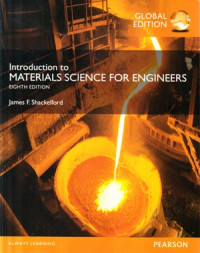Text
Introduction to materials science for engineers
This book is designed for a first course in engineering materials. The field that covers this area of the engineering profession has come to be known as "materi¬als science and engineering." To me, this label serves two important functions. First, it is an accurate description of the balance between scientific principles and practical engineering that is required in selecting the proper materials for modern technology. Second, it gives us a guide to organizing this book. After a short introductory chapter, "science" serves as a label for Part I on "The Fun¬damentals." Chapters 2 through 10 cover various topics in applied physics and chemistry. These are the foundation for understanding the principles of "mate¬rials science." I assume that some students take this course at the freshman or sophomore level and may not yet have taken their required coursework in chem¬istry and physics. As a result, Part I is intended to be self-contained. A previous course in chemistry or physics is certainly helpful, but should not be necessary. If an entire class has finished freshman chemistry, Chapter 2 (atomic bonding) could be left as optional reading, but it is important not to overlook the role of bonding in defining the fundamental types of engineering materials. The remain¬ing chapters in Part I are less optional, as they describe the key topics of materials science. Chapter 3 outlines the ideal, crystalline structures of important materi¬als. Chapter 4 introduces the structural imperfections found in real, engineering materials. These structural defects are the bases of solid-state diffusion (Chap¬ter 5) and plastic deformation in metals (Chapter 6). Chapter 6 also includes a broad range of mechanical behavior for various engineering materials. Similarly, Chapter 7 covers the thermal behavior of these materials. Subjecting materials to various mechanical and thermal processes can lead to their failure, the subject of Chapter 8. In addition, the systematic analysis of material failures can lead to the prevention of future catastrophes. Chapters 9 and 10 are especially important in providing a bridge between "materials science" and "materials engineering." Phase diagrams (Chapter 9) are an effective tool for describing the equilibrium microstructures of practical engineering materials. Instructors will note that this topic is introduced in a descriptive and empirical way. Since some students in this course may not have taken a course in thermodynamics, I avoid the use of the free-energy property. Kinetics (Chapter 10) is the foundation of the heat treat¬ment of engineering materials.
The words "materials engineering" give us a label for Part II of the book that deals with "Materials and Their Applications." First, we discuss the five categories of structural materials: metals, ceramics, and glasses (Chapter 11) and polymers and composites (Chapter 12). In both chapters, we give examples of each type of structural material and describe their processing, the techniques used to produce the materials.
Ketersediaan
Informasi Detail
- Judul Seri
-
-
- No. Panggil
-
620.11 Sha i
- Penerbit
- London : Pearson., 2016
- Deskripsi Fisik
-
680 hal. : il. ; 25 cm.
- Bahasa
-
English
- ISBN/ISSN
-
9780273793403
- Klasifikasi
-
620.11
- Tipe Isi
-
-
- Tipe Media
-
-
- Tipe Pembawa
-
-
- Edisi
-
Ed. VIII
- Subjek
- Info Detail Spesifik
-
-
- Pernyataan Tanggungjawab
-
-
Versi lain/terkait
Tidak tersedia versi lain
Lampiran Berkas
Komentar
Anda harus masuk sebelum memberikan komentar

 Karya Umum
Karya Umum  Filsafat
Filsafat  Agama
Agama  Ilmu-ilmu Sosial
Ilmu-ilmu Sosial  Bahasa
Bahasa  Ilmu-ilmu Murni
Ilmu-ilmu Murni  Ilmu-ilmu Terapan
Ilmu-ilmu Terapan  Kesenian, Hiburan, dan Olahraga
Kesenian, Hiburan, dan Olahraga  Kesusastraan
Kesusastraan  Geografi dan Sejarah
Geografi dan Sejarah  Akuntansi
Akuntansi  Penelitian
Penelitian  Teknik Sipil
Teknik Sipil  Teknik Mesin
Teknik Mesin